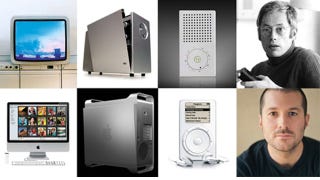4.2 KiB
| created_at | title | url | author | points | story_text | comment_text | num_comments | story_id | story_title | story_url | parent_id | created_at_i | _tags | objectID | year | |||
|---|---|---|---|---|---|---|---|---|---|---|---|---|---|---|---|---|---|---|
| 2009-08-14T17:54:57.000Z | 1960s Braun Products Hold the Secrets to Apple's Future (2008) | http://gizmodo.com/343641/1960s-braun-products-hold-the-secrets-to-apples-future | kirubakaran | 42 | 6 | 1250272497 |
|
763491 | 2008 |
The year 2008 marks the 10th Anniversary of the iMac, the computer that changed everything at Apple, hailing a new design era spearheaded by design genius Jonathan Ive. What most people don't know is that there's another man whose products are at the heart of Ive's design philosophy, an influence that permeates every single product at Apple, from hardware to user-interface design. That man is Dieter Rams, and his old designs for Braun during the '50s and '60s hold all the clues not only for past and present Apple products, but their future as well:
When you look at the Braun products by Dieter Rams—many of them at New York's MoMA—and compare them to Ive's work at Apple, you can clearly see the similarities in their philosophies way beyond the sparse use of color, the selection of materials and how the products are shaped around the function with no artificial design, keeping the design "honest."
This passion for "simplicity" and "honest design" that is always declared by Ive whenever he's interviewed or appears in a promo video, is at the core of Dieter Rams' 10 principles for good design:
• Good design is innovative.
• Good design makes a product useful.
• Good design is aesthetic.
• Good design helps us to understand a product.
• Good design is unobtrusive.
• Good design is honest.
• Good design is durable.
• Good design is consequent to the last detail.
• Good design is concerned with the environment.
• Good design is as little design as possible.
Advertisement
Ive's inspiration on Rams' design principles goes beyond the philosophy and gets straight into a direct homage to real products created decades ago. Amazing pieces of industrial design that still today remain fresh, true classics that have survived the test of time.
The similarities between products from Braun and Apple are sometimes uncanny, others more subtle, but there's always a common root that provides the new Apple objects not only with a beautiful simplicity but also with a close familiarity.
Advertisement
Braun Atelier TV and latest iMac 24.
Braun T1000 radio and PowerMac G5/Mac Pro.
Advertisement
Detail of the radio perforated aluminum surface.
Braun T3 pocket radio and Apple iPod.
Advertisement
Braun L60 sound system and Apple iPod Hi-Fi.
Braun LE1 speaker and Apple iMac.
Some people will probably call these examples a "rip-off" but, in a world where industrial design and art are constantly being recycled into new work, I just see Apple's products as a great evolution to classic concepts. Now, as I look at Rams' work I can't help but to wonder: which of these old Braun designs will Apple revive next? Is there a MacBook Air—the rumored ultra-slim wire-free portable that seems to be the favorite bet for tomorrow's keynote—in there?
Advertisement
Hopefully, we'll discover at least some answers tomorrow. See you at Macworld! [Design Museum, Dieter Rams and O Globo Online]
